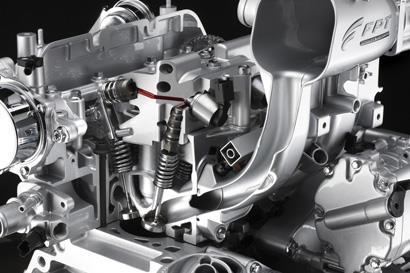Our desire for economical but environmentally friendly transport has driven progress in fuel and oil additives. But as Andy Extance discovers, further development is needed
Our desire for economical but environmentally friendly transport has driven progress in fuel and oil additives. But as Andy Extance discovers, further development is needed

As ignition keys are sleepily turned each morning, car engines’ cylinders flood with fuels that ignite powerfully, little more than a metre from commuters’ faces. Amid the engineering marvels that divert this power away from an explosive awakening for the driver, and towards propelling them safely to work, dance complex mixtures of molecules. The additives that enhance the hydrocarbons in the liquid fuel driving the engine and the oils slipping between its internal components are especially important.
Although combustion engine vehicles are vital for getting us where we want to be, we usually want that ability for the minimum cost. Meanwhile, transport is a major pollution source, making cleaner transport a key weapon in improving the environment. Also, for many drivers getting maximum power from an engine provides unique pleasure. While the kind of car we drive ultimately determines how well these desires are satisfied, fuel and oil additives allow designers to push vehicle engineering ever further in each direction.
According to Simon Mulqueen, technical service manager at fuel additive producer Innospec in Ellesmere Port, UK, meeting one goal can help all three of these challenges. ’If you keep an engine clean, then it works in its optimal design condition,’ he tells Chemistry World. ’You can use that cleanliness to make claims around fuel economy, or emissions, or driveability aspects such as power and acceleration.’ Consequently, the most commonly used fuel additives are detergents. These surfactant molecules’ fatty tails keep them balanced between staying soluble in the fuel as it circulates and maximising their hydrophilic heads’ ability to collect debris.

In Europe, fuel detergents’ value in getting the best out of vehicles is well established, explains John Bennett, senior manager for fuels at additive producer Afton Chemical in Bracknell, UK. As a result, their use has strongly influenced drivers’ behaviour. ’15 or 20 years ago, when supermarkets in the UK first started to sell fuels, they weren’t putting detergents in [to save money and increase profit margins],’ Bennett recalls. When car manufacturers made the UK media aware of this, supermarkets were forced to change their policy. Today the UK’s fuels boast among the highest detergent levels in the world, causing correspondingly low levels of deposit buildup. This contrasts with the US, where minimum additive levels are set by legal mandate and commercial fuel producers raced each other to reach that minimum, again to reduce their costs. But in 2004, to improve the understanding of detergents’ importance, BMW, General Motors, Honda and Toyota developed the voluntary ’Top Tier Detergent Gasoline’ standard, which can now be found all over North America and sets a minimum performance level in terms of engine cleanliness rather than additive content.
But our appetite for cleaner, more economical vehicles is demanding much greater mileage from detergents and other additives. Consistently high fuel prices, and concerns about vehicle emissions, have continued to push car manufacturers’ designs into areas that require additive innovation. ’The trend from car makers is to move to smaller engines, which generate more-or-less the same power as their larger predecessors through turbocharging and supercharging,’ says Brian Crichton from fuel and lubricant additive producer at Infineum International in Oxford, UK.
Efficiency is hot
Smaller engines are more efficient because they weigh the car down less, and less energy is wasted in friction between surfaces. With other conditions held constant in petrol engines, the throttle valve is also more open in smaller engines, meaning less energy is used to pull fuel through. ’The downside of small engines is that managing the heat within them becomes more difficult,’ Bennett comments. This increases the chances of deposit build-up in the engine. ’There has inevitably got to be heat rejected from the fuel system, which means you are heating a hydrocarbon and the chances of it breaking down get higher.’

Other engine design changes include the way fuel is delivered into the cylinder. Direct injection petrol engines currently account for around a quarter of all new petrol cars and are set to become more common. They spray fuel straight into the combustion chamber where it gets much hotter than in more traditional port fuel injector designs. ’There’s been a really big change in temperatures, and that has driven a change in the detergent chemistry,’ Bennett says. ’We found that the older style detergents don’t always work with these new injectors.’
In diesel engines, high speed and common rail direct fuel injection systems have played fundamental roles in reducing emissions. However, they also raise temperatures and pressures to levels that challenge conventional additive formulations. ’Over the last few years, internal diesel injector deposits have been reported increasingly often,’ says Mulqueen. ’The pressures inside these injection systems have changed from around 200 bar up to around 2000 bar. When you’re subjecting fuel to that kind of pressure then different reactions can arise. That’s coupled with the fact that those high pressure systems have much tighter tolerances that help deliver the lower emissions standards. The injector orifice is maybe 100m m in diameter, which is much smaller than has previously been encountered.’
Bennett says that internal diesel injector deposits are unlike carbon-based residues normally left behind by decomposing fuel. Instead, they are often sodium carboxylates derived from the corrosion inhibitors that are intended to protect the fuel distribution system. ’They are borderline soluble, and in certain conditions will come out of the fuel,’ he explains. ’It doesn’t take much insoluble material coming out to start inhibiting the movement of the needle inside the injector body.’ Afton’s latest generation of diesel detergent additives is able to remove these deposits, apparently unlike previous versions. ’To be blunt, the old chemistries wouldn’t remove sodium carboxylates,’ Bennett says. ’We tested it and they don’t.’
Boiling oil

In the quest to give us efficient vehicles, additives are arguably even more important in engine lubricants than fuels, particularly in controlling how viscous they are. ’The important thing is not only having the right viscosity, it’s having viscosity that doesn’t change with temperature,’ explains Peter Seidl from the Federal University of Rio de Janeiro, Brazil. ’If the viscosity changes it will throw the gear out of balance.’ Ensuring consistent, well lubricated engine operation minimises the amount of energy a vehicle uses, he points out.
Infineum’s Crichton explains that polymeric viscosity improvers help deliver this. ’A viscosity modifier allows you to use an oil which is thin at low temperature. A thinner oil means that you have less drag in an engine, and if you have less drag you get more fuel economy. As it heats up, the viscosity modifier - the polymer - uncoils. It modifies the behaviour of the fluid so it doesn’t get so much thinner, but it maintains its low viscosity.’
Seidl’s team has worked to show that adding polymeric viscosity improver additives can boost vehicle fuel economy.1 They have produced lubricants with low enough drag to provide big fuel efficiency benefits, but that remain viscous enough to protect the engine from damage at all temperatures. ’We didn’t expect it to make such a big difference,’ Seidl says, ’because we only did this with a motor. Probably, when we start working with cars, or buses, or trucks that are moving around we will find much larger economy improvements.’
He emphasises the efficiency improvement could add up to a big benefit for those for whom transport is a large expense, like the military. ’They spend an awful lot of money on fuel,’ Seidl adds. ’Any small economy will make a big difference in the cost of transport, or fighting a war.’ Crichton, meanwhile, underlines that with cars in Europe now needing to meet emission targets of an average of 130g of CO2 emitted per kilometre by 2015, vehicle makers are also keen to exploit lubricants to optimise fuel economy.
Yet as these lubricants must now inhabit smaller but equally powerful engines, they face new problems in dealing with the stress they experience. ’It’s all very well putting a nice molecule into new lubricant,’ Crichton says. ’But an engine is like a chemical reactor which has a temperature up to 130-140?C. It has noxious gases flowing through the lubricants. So what we’d like are not only molecules that provide friction reduction at the beginning of the lubricant’s life, but all the way through to the end. We’re looking at ways to protect these lubricants with better antioxidants, and ways to keep the engines cleaner under these more stressful conditions, by including better detergents and dispersants in the lubricants.’
Clean inside and out

Ian Bell, director of engine oils R&D at Afton Chemical, underlines the importance of managing the extra stress from modern engines on lubricants by using better, and not just more, lubricant additives. This is especially clear when trying to improve cleanliness in the pistons being lubricated. ’Engine cleanliness generally requires putting more dispersant or detergent into an oil,’ he says. ’As soon as you put additives in, the oil gets thicker, which reduces fuel economy.’
The latest minimum performance standard for US passenger car engine oils - set by the International Lubricants Standardization and Approval Committee and known as ILSAC GF-5, which came into force in 2010 - presented the lubricant industry with the challenge of improving fuel economy and piston cleanliness simultaneously. ’Those two factors contradict one another,’ Bell underlines. Consequently, Afton had to look more closely at understanding how deposits form in pistons. Through the understanding they gained, Bell and his colleagues could retain the same types of additives in similar amounts but fine-tune the chemistry to meet the new performance requirements.
Zinc dialkyl diphosphates (ZDDPs) are another additive group used in virtually all lubricants. These compounds act to reduce engine wear by decomposing to form complex phosphate glasses on the surface of bearings and other important engine areas under extreme pressure. They also act as antioxidants, chemically protecting the lubricant. ’ZDDPs themselves have been around 60 or 70 years,’ Bell notes. ’They are the most cost effective anti-wear and the most effective antioxidant that we have in the system.’
Today, formulators face the complication that zinc and phosphate residues from ZDDP breakdown, along with sulfur and sulfated ash from lubricant detergents and dispersants, disrupt catalytic converters. Consequently, even as engine oils are being put under increasing stress, car makers have demanded reduced sulfated ash, phosphate and sulfur (SAPS) lubricants. One way in which Afton has tackled this is by introducing titanium-based additives that help boost anti-wear performance,2 which have already been commercialised. And although they’re still used alongside ZDDP, the titanium additives help control catalyst contamination by SAPS. ’It’s a different chemistry, not phosphorus containing,’ Bell says.
Beyond ensuring catalytic converters can continue to reduce pollution from cars, Afton intends that the titanium molecules provide better protection for the engine. To do this they had to tailor their characteristics. ’They need to be soluble enough to be transported in the engine, but insoluble enough to be then attracted down to the surface,’ Bell explains. ’Also, there’s no point in having something that’s so active on the surface it will stick like superglue onto it, because it will stick where it doesn’t need to stick. You’re trying to get the right balance between solubility and surface activity.’ Afton’s scientists believe the resulting compounds form protective FeTiO3films on the engine surfaces. ’The titanium chemistry gives us a large benefit in terms of engine protection,’ Bell says.
Satisfying our desire to travel in a way that minimises fossil fuel use underlies most recent advances in fuel and lubricant additives. However, for full sustainability, there is still one major step the industry has to take, observes Crichton. ’Virtually all of our industry is based on materials that are in one way or another not renewable,’ he says. ’The backbones to most of our molecules are petrochemically derived. We use non-renewable carbonate salts as colloidal dispersions.’ Research into shifting to alternative feedstocks is now ongoing, according to Crichton. ’If we can move to more renewable resources, we think that could offer true benefits.’
Andy Extance is a freelance science journalist based in Exeter, UK
References
1 ?M J Souza de Carvalho et al, Tribol. Int., 2010, 43, 2298 (DOI:10.1016/j.triboint.2010.07.014)
2 J M Guevremont et al, Tribol. Trans., 2008, 51, 324 (DOI: 10.1080/10402000701772595)






No comments yet